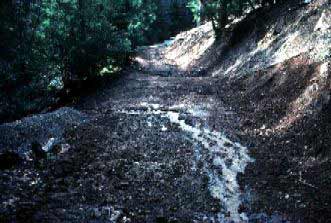 |
| Fall / Winter 2000 |
Vol. IX, No. 3
|
|
In This Issue:
 We introduced you to the Trinity County Backyard Conservation Program in the summer issue of the Conservation Almanac. In this issue we are featuring the first of six conservation topics central to the theme that Conservation Begins at Home! Cynthia Tarwater, the RCD’s Implementation Coordinator, discusses some important things to remember about roads and sediment. Look for our next article on the Use of Native Plants in the Spring 2001 Conservation Almanac. In coming months, we will provide information on Riparian Habitat Improvement, Defensible Space for Wildland Fires, Water Quality Monitoring, and Water Conservation.
We introduced you to the Trinity County Backyard Conservation Program in the summer issue of the Conservation Almanac. In this issue we are featuring the first of six conservation topics central to the theme that Conservation Begins at Home! Cynthia Tarwater, the RCD’s Implementation Coordinator, discusses some important things to remember about roads and sediment. Look for our next article on the Use of Native Plants in the Spring 2001 Conservation Almanac. In coming months, we will provide information on Riparian Habitat Improvement, Defensible Space for Wildland Fires, Water Quality Monitoring, and Water Conservation.
EROSION CONTROL
With the recent rains, how many of you have noticed water running everywhere, in particular down your driveway? I have been doing some shovel work to address this same problem since the fall rains started. Some landowners have just a driveway off of a main road, but many of us have longer access roads that could cause erosion problems in heavy rains. Unsurfaced roads, driveways, and even horse trails can accelerate erosion problems and contribute sediment to our rivers and streams.
Water generally travels down a road just as you and I do. Roads actually collect and channel water, interrupting the natural drainage of water across the landscape.
Four Basic Steps to Minimize Erosion Problems
Protect bare soil surfaces. Vegetation is the best protection because it both absorbs and uses water. Mulches, such as straw and wood chips, are also effective to protect the soil surface. Be sure any straw is certified weed free or you could end up with an invasive weed problem.
Don’t concentrate water flow unless absolutely necessary. On undisturbed slopes, water percolates through soil slowly and uniformly. Even during heavy rainfall, runoff flows evenly over the ground into the nearest drainage. When runoff is focused on one spot, such as by a culvert or a rain gutter, the soil surface can not withstand the force of the water and begins eroding. If you must focus runoff, protect the outflow area with an energy dissipator, such as rock or securely anchored brush.
Limit livestock and human use of vulnerable areas. Livestock and people can exacerbate mild erosion by disturbing vegetation and creating trails that channel flow. Avoid disturbance to fill slopes, creeks that have abrupt changes in gradient, winter swales, unsurfaced roads, old landslides, and any site that shows signs of recent soil loss.
Disturb existing vegetation as little as possible. Plants hold the soil in place with their roots, regulate the speed of water flowing through and over the soil, and protect the soil surface, as well as provide cover and food for wildlife. The native plant community is especially well adapted to suit specific soil and rainfall conditions. Once the native plant community is disturbed, the soil below becomes more susceptible to erosion. |
However, this is not good for the roads or the streams; water will take fine material like clay and silt from the road surfacing, and soften poor soils. If you pay close attention during storms, you’ll notice the paths that the water takes and see areas where you can get the water off of the road with a little shovel work. Obviously, there is a limit to what you can do by hand, but give it try, be patient, and be creative. You can make a difference!
On longer access roads, rocked, rolling dips should be constructed by knowledgeable equipment operators. Rolling dips are used where the road crosses small, seasonal streams. The rolling dip forces the stream to stay in the natural channel, instead of following the road. Lastly, don’t forget to protect areas with energy dissipators where excess water is discharged. Energy dissipators can be as simple as placing brushy material or rock at outlet areas to slow the water down enough that it reduces erosion.
If you need assistance or guidance for your private road or driveway or other “Backyard” issues, contact the District at 623-6004.
Back to top |
Trinity County Fire Safe Council Planning
The Trinity County Fire Safe Council (FSC) seeks to improve cooperation and coordination in all aspects of wildfire management in Trinity County. Members include governmental agencies, the local Volunteer Fire Departments, and citizens. A countywide Fire Management Plan is needed to assist in prioritizing and coordinating activities such as pre-fire fuels reduction treatments.
 |
Fire Safe Council Presentation on November 16th
County or regional wildfire management plans often fail to involve or even to acknowledge local residents’ knowledge and expertise. FSC members feel strongly that community input should drive the Trinity County Fire Management Plan development process with local and regional expertise. In 1999 with funding support from the USFS Pacific Southwest Research Station and the State Department of Water Resources, a team from the FSC began a process to capture community recommendations for this planning effort.
A series of community meetings and public workshops was held at Volunteer Fire Department Halls and community centers across Trinity County. Residents were asked to help identify and map features relevant to emergency response, including locked gates, bridges too weak to carry a fire truck, water sources, and other features. Community members also worked with the team to locate and specify values at risk from fire in and around their communities. They made recommendations about pre-fire treatments, such as clearing defensible space around residences and constructing shaded fuel breaks along roadsides that could help to protect these values. Finally, they jointly developed a ranking system and prioritized recommended projects. Data from these meetings were captured and entered into a Geographic Information System (GIS).
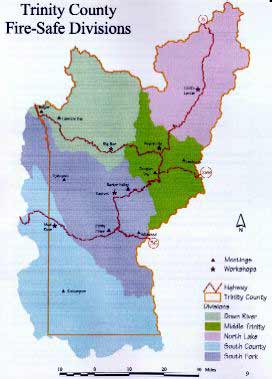 |
Click on image for larger view
The FSC presented the latest version of these recommendations at its meeting on November 16th. There were approximately 35 people attending from a diverse spectrum, including the USFS District Rangers for Hayfork and Weaverville, Bureau of Land Management’s Redding Resource Area Manager, a member of the Trinity County Planning Commission, Trinity County Planning Department, a member-elect of the Trinity County Board of Supervisors, members of SAFE, the Watershed Research and Training Center (WRTC), Natural Resource Conservation Service, Resource Conservation District, the President of the Volunteer Fire Department Chiefs Association, and other residents of the county.
Draft results of the Recommendations on Trinity County Values at Risk from Fire and Pre-Fire Fuels Treatment Opportunities drawn from Community Meetings 1999/2000 were presented by Dr. Yvonne Everett, professor of Natural Resources at Humboldt State University. The table on the next page lists the top five project sites identified for each of the five FSC regions of Trinity County; 1) Down River, 2) Mid-Trinity, 3) North Lake, 4) South County, and 5) South Fork.
CONCLUSIONS & NEXT STEPS
The most frequently recommended methods of pre-fire treatment identified through this process were general fuels reduction efforts, followed by shaded fuel break construction and maintenance, and stand and plantation thinning. Recommendations for individual landowners to treat their own fuels and for neighborhood groups to work together to reduce fire hazard and emergency response problems also were stressed.
Top Fire Safe Projects by Region
|
Down River
- Hennessy Road
- Cedar Flat South
- Green Mountain/Wilderness
- Hawkins Bar
- Trinity Village
|
South Fork
- Brady Road
- South Fork Mountain Ridge
- Lucky Jeep Trail - Thompson Peak
- Randolf and Jones Burns
- Tule Creek Road
|
North Lake
- Coffee Creek Community
- Trinity Center
- Coffee Creek Road
- Covington Mill
- Long Canyon
- Trinity Alps Resort
|
South County
- G. Stewart Ranch
- East side of Ruth Lake
- Ruth Lake Rd. to Wild/Mad
- Burgess/Zenia ranchland
- Lower Van Duzen Rd. Corridor
- Stewart Game Management Unit
|
Mid-Trinity
- Oregon Mtn. north to Musser Hill
- East Branch Community
- Musser Hill-East Weaver Creek
- Hwy 299 - Grass Valley Creek
- Timber Ridge BLM
|
| Note: Values at risk include schools, communities, plantations, resorts, water supply, recreation, fish and wildlife, and old growth forests. |
|
|
The FSC, including the Trinity County RCD and the WRTC, will continue to coordinate systematic implementation of the projects recommended by the community participants. Further, it will encourage public land management agencies to complete the necessary permitting such as National Environmental Protection Act (NEPA) Environmental Assessments required before many recommended activities can be carried out.
The Fire Safe Council hopes that these recommendations are useful to everyone involved in fire management.
- The Trinity County Board of Supervisors can use the recommendations to ensure that the voice of the county is heard in public land manager’s decisions about fire management.
- The USFS and BLM can use the information as they gather community input on fire planning.
- Trinity County Planning Department can use the recommendations in updating the Safety Element of the General Plan.
- VFDs can use this plan in the next phases of county level coordination of emergency response, and to implement recommendations.
Back to top
The California Envirothon
District Chairman Elected President
Trinity County RCD chairman Greg Lowden was elected President of the California State Envirothon Steering Committee in September 2000. Lowden served as the Northern California representative to the Steering Committee for 6 years prior to his election.
The California Envirothon is a program designed to be a written and hands-on competition of high school students’ knowledge of California’s natural resources including soils, forestry, wildlife, aquatics, and a yearly environmental topic. Last spring, over 155 students from 31 high schools throughout California participated in the Envirothon competition at Walker Ranch in Petaluma. Hayfork High finished 9th place overall. After the statewide competition, the winning team from each state then goes on to the Canon National Envirothon held at the end of the summer.
Lowden said he “was honored to have the opportunity to serve in this new role,” and hopes that the steering committee “will be successful in expanding high school participation throughout the state, and in the north state in particular.”
Steering Committee members include representatives from Resource Conservation Districts, California Association of Conservation Districts, federal, state and local governments, the agriculture community, and the education field.
Back to top |
South Fork CRMP Tours Restoration Sites
The South Fork Coordinated Resource Management Planning (South Fork CRMP) group hosted a tour of restoration sites on October 17th. Bill Huber, CRMP Coordinator, organized the tour to review restoration projects implemented by the Trinity County RCD and the USFS Hayfork District. The tour highlighted stream crossings on two roads that had been identified as significant sources of sediment to area streams.
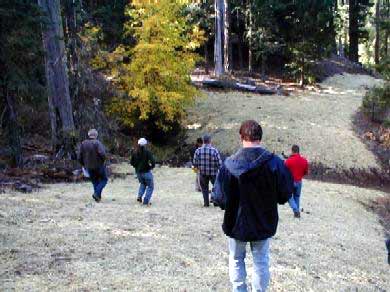 |
Review of a South Fork restoration site
The 28N10B Road was completed by the RCD under the supervision of Cynthia Tarwater, Implementation Coordinator. The work included the removal of several undersized or damaged culverts to reconstruct stream channels to handle flows from winter rains and reshaping the road to promote a more natural flow of water. A similar project on Buck Ridge was designed and undertaken by the USFS on a spur of 28N40 Road. The tour group, including Donna Harmon, Hayfork District Ranger and Bill Weaver of Pacific Watershed Associates, an expert in forest road design and repair, evaluated the completed projects and provided suggestions on design improvements. These roads will be revisited after the rainy season to help ongoing efforts to reduce road-related erosion in the South Fork Trinity River watershed. |
Plants Out of Place
A weed is simply a plant out of place. A plant is considered a weed when it grows in place of desired plants whether that is in your backyard, along the stream running through your property, on the side of the highway or in the beautiful wildlands of our county. Simply stated, weeds steal moisture, nutrients, and sunlight from surrounding desirable plants. Exotics or non-native species are the most troublesome weeds. An explosion of invasive weeds is overrunning California. These non-native weeds, such as yellow starthistle, fall under the classification of noxious weeds. Noxious weeds are weeds that are so designated by state law or county ordinance, because they cause, or can cause, extraordinary negative economic and ecological impacts.
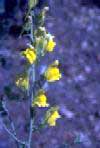
Dalmatian toad-flax |

Dyer's woad |

Scotch broom |
|

Klamath weed |

Spotted knapweed |
|
Some noxious weeds in Trinity County;
click an image for a larger view
The Trinity County Weed Management Cooperative (TCWMC or the Cooperative) was established at the end of 1999. The Cooperative includes county, state, and federal agencies, non-profit organizations, and individuals who are generally concerned about the spread of noxious weeds across California and throughout Trinity County in particular. The organizations of the Cooperative believe that we all need to work together to effectively deal with the ever-increasing problem of noxious weeds. Plants do not recognize property boundaries. The actions, or inactions, of our neighbors can have serious impacts on the success, or failure, of noxious weed management.
In an effort to inform our neighbors about noxious weeds in Trinity County, future issues of the Conservation Almanac will include an article about a noxious weed of concern in Trinity County. The noxious weeds shown here in the photos were identified by the Cooperative as weeds existing in Trinity County that pose an economic and/or ecological threat to our county. The TCWMC is currently putting together an educational brochure that will help you identify these weeds on your property and manage weed populations to minimize impacts.
We look forward to answering any weed questions you might have and invite anyone who is interested in noxious weeds to join our meetings. Call the TCRCD for more information.
District Manager's Corner
by Pat Frost
I always am invigorated by autumn. The golden richness of the oaks and the clusters of bright red berries dangling from the branches of dogwoods tell me that it is the harvest season. I am reminded of the old saying, “you can only reap what you sow”. I take heart that I have the good fortune to live in Trinity County, and that we benefit from the seeds that we have sown. I have never before lived in a community that has so many dedicated, energetic individuals – so many people willing to give of their own time to help each other and to help the District reap an annual harvest of resource conservation. Some excellent examples are included in this issue of the Conservation Almanac.
Soil erosion has been a core resource issue for conservation districts for decades. The work of the South Fork CRMP to bring together landowners in a partnership to reduce erosion and improve water quality in the South Fork Trinity River watershed bears fruit every year. And now, through our Backyard Conservation Program we hope to extend our assistance to landowners throughout the county, as described in our feature article on page 1.
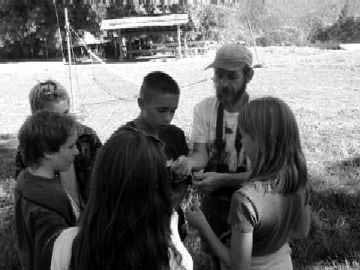 |
Environmental Camp at Bar 717
The Fire Safe Council has brought together landowners, volunteer fire departments and land management agencies over the past six months planting the seeds of a changing attitude towards forest health and fire management in Trinity County. In this issue you can review a summary of our progress, which has been substantial. Trinity County is well ahead of most regions in California, because we already are developing a fire management plan (see article above). The seeds that we have sown should help us reap financial assistance to implement projects throughout the county. Congress and the President have allocated millions of dollars for community assistance programs under the umbrella of the National Fire Plan. To be successful, we will need to continue to work together – private and public lands managers; county state and federal agencies; large and small landowners cooperating to make our forests healthier and safer.
Educating ourselves about conservation issues is an important tool. This past fall the RCD has had the opportunity to participate in two excellent educational projects designed to cast the seeds of conservation education on the fertile ground of our youth. The Weaverville Elementary School 6th Grade classes returned to Bar 717 Ranch this September. David Newton and Jean Yoho, their teachers, and several parents put together an exciting curriculum that blended environmental education with the wonderful outdoors classroom that the ranch offers. The RCD led students through morning hikes that taught them about riparian (streamside) habitats, bird identification and the diversity of habitats in Trinity County. Hayfork Creek served as our living laboratory where students learned to measure the stream’s physical features and survey for animals that help us understand stream health. Mark Lancaster and Kenneth Baldwin shared the pleasure of the forestry
unit and Jim Spear, District Conservationist with NRCS, taught all about soils.
 |
Kids fishing for treats at the Salmon Festival
Anyone who strolled through Lee Fong Park on October 7th knows that the second Annual Salmon Festival was packed full of fun and information. The RCD booth, featuring our Backyard Conservation program and Riparian Education project had something for everyone. There was a raffle for birdhouses, helpful hints for birdfeeders, and brochures ranging from streamside care to the use of native grasses in your landscape. But the highlight of the booth had to be the children’s “go fish” activity, if the number of repeat visits to the fishing hole is any indicator. Kids of all ages answered wildlife and habitat questions for a chance to cast a line for goodies. A companion booth set up by the Weaverville Basin Trail Committee gave visitors a chance to learn more about the trail system from trail volunteers.
As I review this issue of the Conservation Almanac I want to thank everyone who has contributed their time and experience to our conservation projects, and I am sure that all of us will continue to reap the benefits of their efforts.
Back to top |
Return to the Trinity County RCD home page
|





